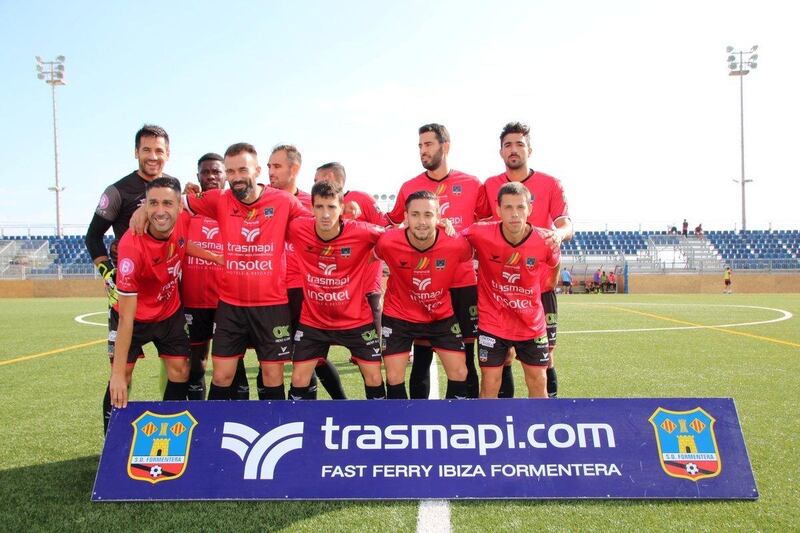Although the political climate remains hot, temperatures have started to cool in Spain this week as the tourist season closes.
Nowhere notices the contrast more than the tiny Balearic island of Formentera, a fashionable holiday destination in the high summer, with turquoise waters and white sandy beaches.
In winter, the nearly 20-kilometre slip of an island which sits 6.4km off the coast of Ibiza and does not have its own airport shrinks back to its 11,000 population. The remote, idyllic, location made it popular with hippies in the 1970s.
___________________________________
Read more:
Podcast: Premier League predictions - Who wins the Man United-Tottenham blockbuster?
Harry Redknapp interview: Pochettino's Tottenham 'stronger all-round' compared to my 2010/11 side
Richard Jolly: Klopp and Wagner share zest for high-octane football on pitch and bromance off it
___________________________________
SD Formentera have long been a local team, playing for the majority of their history against fellow island sides in front of 100 spectators, until in 2012 they rose to Spain’s regional fourth division.
After four play-off attempts, they were promoted to the third tier for this season.
Away matches include a ferry to Ibiza then one or even two flights to Spain’s mainland or to one of the two Mallorcan teams. Even with subsidies, travel costs can be so prohibitive that teams prefer not to get promoted.
Formentera are now playing Mallorca, Elche and Murca, who can all attract five-figure crowds.
Formentera’s municipal stadium had two tiny stands holding 500 until this season, when five temporary stands were erected to boost the capacity to 3,000. There are markings for other sports on the artificial surface.
Players, most of whom come from the mainland, share lodgings.
📢Aquí teniu el vídeo promocional de la #CopadelRey🏆🆚 @AthleticClub
— SD FORMENTERA ⚽ (@sdformentera) October 21, 2017
Vine a la festa del 25-O. Un partit per somiar!!
📽️by @xavi_oliverjavi pic.twitter.com/QmLSKAJhyw
This season, Formentera were paired with Athletic Bilbao in Spain’s Copa del Rey. With memories of a 14-2 aggregate hammering from Sevilla last season still fresh, nobody was getting too excited.
Formentera, with two wins from their 10 league games so far this season, are in a fight to stay up, but a club record crowd of 2,376 came to the tie. The population of Sant Francesc Xavier, where Formentera play, is 2,790. Former Athletic midfielder Joseba Garmendia helped the unfancied Formentera hold Athletic to a 1-1 draw, their greatest ever result.
The King’s popularity varies greatly around Spain at present, but every Spanish team want to win the King’s Cup. There is a problem with the format of the Copa del Rey, though.
The last 32, when the biggest clubs enter and are paired against the smallest, is over two legs. That gives the biggest clubs two chances to beat the minnows and kills the chance of one-off cup upsets, especially as the giant is at home in the second leg.
Som la @sdformentera i aquesta es la nostra afició en la visita del @AthleticClub a la #CopaDelRey 🔝👏#AmuntFormentera pic.twitter.com/71V5hJGm6y
— SD FORMENTERA ⚽ (@sdformentera) October 25, 2017
Not only that, the second leg is a non-event if the giants win the first leg.
Athletic Bilbao will have to be on form to overcome Formentera, but Barcelona won their away game 3-0 at third-tier Real Murcia. What is the point of the second leg at Camp Nou at the end of November?
Barca will lower ticket prices and season-ticket holders will be able to watch the game as part of their ticket, but the result is a foregone conclusion.
Instead, it is an opportunity to try out B team players like Jose Arnaiz, the 22-year-old winger who joined Barca in the close season for a fee of €3.4 million (Dh14.7m) from Real Valladolid. There are echoes of Real Madrid signing Marco Asensio from then second-tier Mallorca for a similar fee.
🏋️⚽️ The available first team players train on the Tito Vilanova pitch 🔴🔵 #ForçaBarça pic.twitter.com/0nkhE3lQ0b
— FC Barcelona (@FCBarcelona) October 26, 2017
Purists of the Barca system note that buying a player who was already proven in Spain’s second division hardly makes him a product of the youth system. He turned down offers to play for Getafe and Leganes in the Primera Liga in order to continue his development at Barca, but he is 22, not 18.
Arnaiz has been excelling for Barca B in Spain’s second tier and was given his first team debut in Murcia on Tuesday, scoring in the 64th minute. He is fast and uses two feet.
It will be difficult for him and other exciting B team players - including Carlos Alena, a 19-year-old Catalan midfielder who has been with the club since the age of seven and who made his debut last season - to establish themselves. Alena already has a release clause of €75m.
Hopes are high for Arnaiz and Alena, but they have been for three or four players each season, most of whom have had good careers, but not at Barca.






